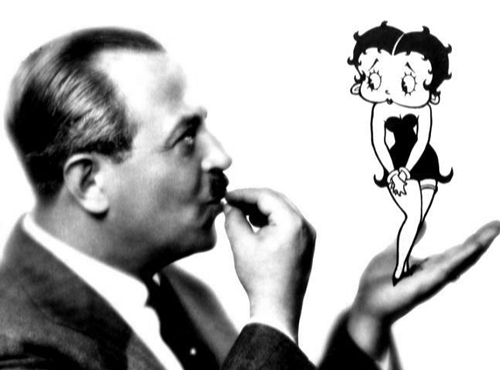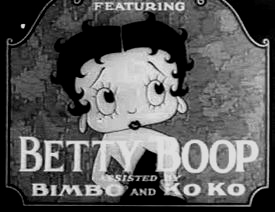Reviewed by Glenn Erickson
Made of pen and ink! She can win you with a wink!
(yoo hoo!)
Ain't she cute
(Boop-boop-a-doop!)
Swee-eet Betty!
The risqué darling of the Depression years, Betty Boop was sensationally popular, almost as popular as Dave and Max Fleischer's Popeye. Like most producers of the 20s and 30s trying to get a toe hold on the barely lucrative animated short subject business, Fleischer and his staff invented or licensed dozens of characters -- but none had the 'special' appeal of "sweet Betty."
A parody of a late '20s flapper, Betty Boop is a pneumatic cutie in an abbreviated costume that accentuates little round breasts (yes! in a cartoon character) and a racy garter on one thigh. At least in the Pre-code era, Betty flaunts her body, winks at men and plays the innocent as she sends out all the desired signals, including the unequivocal "yoo hoo!" call. She squeals with satisfaction at every sign of affection, or even if a gust of wind throws her skirt up. Heck, she'll show her underwear any time at all, followed by a mock gesture of embarrassment. Asked what she, does in one cartoon she answers, "I Boop-boop-a-doop!" In other words, Betty Boop is the animated answer to Mae West, except that being a cartoon character apparently helped her slip more easily under the censorship radar. All those hundreds of local state and municipal censorship agencies were having too much trouble keeping real near-nudity out of live action studio films.

Although other actresses served as well, actress Mae Questel is tagged as Betty's principal voice artist. If the name sounds unfamiliar, Questel has a featured part 35 years later in Barbra Streisand's Funny Girl, and brings the accent with her. Her Betty sounds adorable, almost infantile. Betty has been described as having a baby's head atop a mature female body. Like many animated characters, she underwent an evolution, in this case one that Dr. Moreau might approve of -- Betty started out as a humanoid French Poodle, with doggy ears no less. By 1930 or so she decided to be just plain human. As for the general inspiration, Ms. Boop is awfully close to the stage and screen persona used by comedienne Helen Kane, whose signature was the Boop-boop-a-doop! phrase.
Olive's Betty Boop: The Essential Collection Volume 1 begins in 1932, a couple of years after Betty became a 'solo' star. Two years of talkie cartoons are not accounted for in this collection; many of them may be in the Public Domain. The cartoon dog Bimbo is Betty's constant companion in the early cartoons, many of which mixed and matched our girl with other Fleischer characters. All of the cartoons have lively jazz soundtracks, some of them featuring tunes and vocals by Cab Calloway.
What are the cartoons like? They're insane. Most setups use the Fleischer "Toontown" style perfectly recaptured in 1988's Who Framed Roger Rabbit?, in which main characters, background extras, inanimate objects and even background features "bop" with the beat of the music -- usually a jazz band flat four rhythm. Some of the cartoons have a central situation but no linear story, just a framework on which to hang a series of gags. Surreal and Bizarre are good descriptors for the goings-on; Warners' "Wackyland" cartoons are tame by comparison. Inanimate objects come to life or imitate animals for no reason at all, as when a boat anchor momentarily becomes a "dog" to dry itself off. Anything can transform into anything. Betty, Bimbo and Koko the Clown become chess pieces in one cartoon. Anything that can morph into a form that can tickle, molest or simply ogle Betty will do so -- pulling up her skirt is the usual thing to do. After seeing a couple of these cartoons, with their marvelous jazzy soundtracks and completely demented content, one can see why they were a cult item with dopeheads of the '60s and '70s. Tweak this surreal Fleischer world a bit, and you've got the obscene land of Robert Crumb in Zap comix.
Political correctness missed this bus, sorry. The animation design invites the viewer to check Betty out. When Betty dances, it looks as if she were carefully roto-scoped from live-action rehearsal footage -- all of her anatomical (cough) details move in a familiar way. With this series, Fleischer at least found one way to keep the animators' mind on their work. There are also gay jokes - he-men transformed into pansies, etc. -- and the expected black jokes, with ink and soot changing characters into minstrel show caricatures.
Poor Betty was seriously clobbered by the enforcement of the Production Code in 1934. As one might expect, when she stopped being a sexual come-on character, she no longer had a reason for being. Gone were Betty's naughty ways, her abbreviated costume, etc.. She was given a steady boyfriend, which put her under 'sensible' masculine control. In later cartoons a dog named Pudgy provides non-sexual cute gags. The twelve-cartoon collection skips from 1934 to 1937 for one final entry that shows how the bluenoses robbed Betty Boop of her sexuality.

All the cartoons were bought by the UM&M TV Corporation, whose logos wipe out the original Paramount logos. Paramount's mountain still appears in the title art, and we can still hear the "Paramount Fanfare" familiar from newsreels on a cartoon or two. In the earliest titles Betty appears in a character intro strutting with her hands on her hips, interjecting her cutsie voice into a brief jingle: Ain't she cute! (Boop-boop-a-doop!) Swee-eet Betty!
Here's a rundown on the contents, with a note or two:
1932
Chess-Nuts The crazy happenings are bookended by live action. Bimbo and Koko the clown become chess pieces along with Betty.
Betty Boop M.D. Betty shills for a medicine-oil salesman. More non-sequitur gags than usual; in the final gag a character turns into a perfect replica of Fredric March as Mr. Hyde.
Betty Boop's Bamboo Isle Betty and Bimbo take a tiny boat to a tropic isle, where a topless Betty (well, she does wear a Lei of flowers) dances a saucy hula.
Betty Boop for President Betty campaigns against Mr. Nobody. Clever song lyrics. Gags about the stalemate between Republicans and Democrats feel very contemporary. A superimposition tells us that candidate Betty endorses the repeal of Prohibition!
1933
Betty Boop's Penthouse Voyeuristic gags segue into a scene of Betty being pursued on the rooftop by a monster.
Betty Boop's Birthday Party The first of three party- oriented shorts, with disconnected gags.
Betty Boop's May Party This one takes place on a boat.
Betty Boop's Hallowe'en Party Some barnyard animals come to party, and are interrupted by a (King Kong-like?) big hairy monster.
1934
Betty Boop's Rise to Fame In live-action footage, Max Fleisher draws Betty for a reporter (Dave Fleischer). She reprises some musical numbers, like the sexy hula dance seen above. She also undresses more than once, to change costumes -- the animators have fun with those scenes. The highlight is "The Old Man of the Mountain", a duet sung with Cab Calloway.
Betty Boop's Trial Harassed by an amorous motorcycle cop, Betty flees and is put on trial. Will a jury of twelve voyeuristic old men acquit her?
Betty Boop's Life Guard When a strangely feminine lifeguard is too slow to rescue her, Betty sinks, becomes a mermaid and sings a song at the bottom of the ocean.
1937
The Foxy Hunter This is the post-Code abomination. The featured star is Pudgy the Dog, while Betty gets barely a minute of screen time. She's a cook or a housekeeper and her only function is to act motherly. Her 'respectable' costume is suitable for Zazu Pitts. Although it does show some leg, there's no garter and no tease. This must have spelled doom for the series.
According to the box copy this is the first of four Boop Collections coming from Olive, so there will plenty more ribald fun on the way. Volume 2 is due in just a month. These are a sure hit and a real eye opener.
Olive Films' Blu-ray of Betty Boop: The Essential Collection Volume 1 gives us great B&W HD transfers of the cartoons, in excellent condition. A few have speckles here and there, but the fact that they haven't been digitally cleaned up is a good thing, as the images are so sharp that we can spot minor animation errors and glitches. And the UM&M Logos aren't much of a bother, either.
This should be a solid hit for animation fans -- and we hope somebody rescues the Public Domain titles as well. I remember UCLA showing some titles from 1930 or so that were even more demented than these. Hopefully the elements for them haven't been destroyed.
On a scale of Excellent, Good, Fair, and Poor,
Betty Boop: The Essential Collection Volume 1 Blu-ray rates:
Cartoons: Excellent
Video: Excellent
Sound: Excellent
Audio: English
Supplements: none
Deaf and Hearing Impaired Friendly?
N0; Subtitles: None
Packaging: Keep case
Reviewed: August 15, 2013

DVD Savant Text © Copyright 2013 Glenn Erickson
See more exclusive reviews on the Savant Main Page.
Reviews on the Savant main site have additional credits information and are often updated and annotated with footnotes, reader input and graphics.
Return to Top of Page
|

